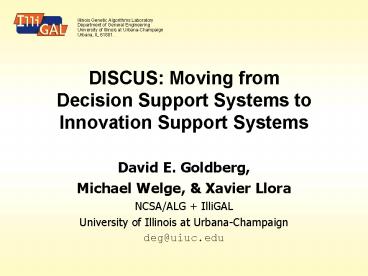DISCUS: Moving from Decision Support Systems to Innovation Support Systems - PowerPoint PPT Presentation
1 / 18
Title:
DISCUS: Moving from Decision Support Systems to Innovation Support Systems
Description:
DISCUS: Distributed Innovation and Scalable Collaboration in Uncertain ... Key elements of DISCUS. Three Elements from TB. IlliGAL has ... With DISCUS ... – PowerPoint PPT presentation
Number of Views:100
Avg rating:3.0/5.0
Title: DISCUS: Moving from Decision Support Systems to Innovation Support Systems
1
DISCUS Moving from Decision Support Systems to
Innovation Support Systems
- David E. Goldberg,
- Michael Welge, Xavier Llora
- NCSA/ALG IlliGAL
- University of Illinois at Urbana-Champaign
- deg_at_uiuc.edu
2
Innovation This Innovation That
- The business world is abuzz with innovation.
- Popular books tell companies how to get it.
- But little scientific understanding of what it
is. - UIUC research changing that.
3
Decision Support Knowledge Managementversus
Innovation Support
- Decision support systems help evaluate enumerated
alternatives. - Knowledge management helps manage that which is
known. - Is it possible to create new class of innovation
support system to systematically permit
organizations to use IT to support pervasive and
persistent innovation?
4
Collaboration Key Ideas Opportunity
- Previous collaboration of ALG IlliGAL
- Applications-ready GA theory
- MOGAs for D2K the real world
- Interactive genetic algorithms
- Confluence of key ideas
- Interactive GAs
- Human-based GA (Kosorukoff Goldberg, 2002)
- Chance discovery data-text mining
- DISCUS Distributed Innovation and Scalable
Collaboration in Uncertain Settings
5
Overview
- 3 elements research from IlliGAL
- 4 trips to the South Farms
- 2 trips to Japan
- The innovation connection
- The key problem interactive superficiality
- KeyGraphs as aid to reflection
- Key elements of DISCUS
6
Three Elements from TB
- IlliGAL has studied principled
- Genetic algorithm design theory
- Genetic algorithm competence
- Genetic algorithm efficiency
- Design theory permits analysis w/o tears.
- Competence solve hard problems, quickly,
reliably, and accurately ? O(l2). - Efficiency takes tractable subquadratic solutions
to practicality.
7
Four Trips to the South Farms
- Collaboration had blossomed with ALG Prof.
Minsker on - Carrying principled design theory to practice
- Multiobjective selection to D2K practice
- GBML and HBGAs to D2K
- Interactive GAs
- Keys for the current project
- HBGAs
- Interactive GAs
8
Interactive Human-Based Genetic Algorithms
- Interactive GAs replace machine eval with human
eval - Human-based GAs replace ops eval with human
www.3form.com
9
Two Trips to Japan
- Visited Tsukuba University, Graduate School of
Systems Management, December 2001 January 2002. - Met KeyGraph Inventor Chance Discovery
Proponent, Yukio Osawa. - Did Tutorial with Dr. Osawa August 2002.
- Finally understood importance of topic relation
to GAs.
10
Modes of Innovation
- GA as model of innovation
- Kaizen selection mutation
- Discontinuous change selection crossover
- Chance discovery
- Low probability events linked to matters of
importance - Keygraphs as one computational embodiment of
chance discovery.
http//www-doi.ge.uiuc.edu
11
Innovation This Innovation That
- The business world is abuzz with innovation.
- Popular books tell companies how to get it.
- But little scientific understanding of what it is.
12
SelectionRecombination Innovation
- Combine notions to form ideas.
- It takes two to invent anything. The one makes
up combinations the other chooses, recognizes
what he wishes and what is important to him in
the mass of the things which the former has
imparted to him. P. Valéry
13
Scalable Solutions on Hard Problems
- Time to first global averaged over five runs.
- Subquadratic versus quintic.
- Compares favorably to hillclimbing, too
(Muhlenbein, 1992).
14
KeyGraph Example Japanese Breakfast
Figure KeyGraph (Ohsawa, 2002) shows two
clusters of food preferences for Japanese
breakfast eaters. The chance discovery of rare
use of vitamins was viewed as a marketing
opportunity by food companies.
15
Key Problem Notion
- Human-based GAs interesting, but suffer from
interactive superficiality. - KeyGraphs have been used to gain insight into
text data, but usually batch mode of processing. - Combine interactivity of HBGAs and insight
promotion of KeyGraphs. - Boost everything with competent efficient GAs and
IEC at population outskirts.
16
Summary
- 3 imports from IlliGAL
- 4 trips to South Farms
- 2 trips to Japan
- The innovation connection
- Key problem interactive superficiality
- Possible solution interactive collaboration with
reflection boosted by KeyGraphs - Larger framework with competent interactive
GEC.
17
More Information
- Visit IlliGAL web site.
- http//www-illigal.ge.uiuc.edu/
- Recent book Goldberg, D. E. (2002). The Design
of Innovation. Boston, MA Kluwer Academic. - Attend GECCO-2003, Chicago, July 12-16, 2003,
www.isgec.org/GECCO-2003/.
18
People Involved With DISCUS
- llinois Genetic Algorithms Lab - Department of
General Engineering - University of Illinois at
Urbana Champaign (IlliGAL-UIUC) - David E. Goldberg, Xavier Llorà, Kei Ohnishi,
Tian Li Yu, Martin Butz, Antonio Gonzales - Automated Learning Group - National Center for
Supercomputing Applications (ALG-NCSA) - Michael Welge, Loretta Auvil, Duane Searsmith,
Bei Yu - Knowledge and Learning System Group - National
Center for Supercomputing Applications - Tim Wentling, Andrew Wadsworth, Luigi Marini, Raj
Barnerjee - Data Mining and Visualization Division - National
Center for Supercomputing Applications - Alan Craig
- Deparment of General Engineering - National
Center for Supercomputing Applications - Ali Yassine, Miao Zhuang
- Minsker Research Group - Department of Civil and
Environmental Engineering - University of
Illinois at Urbana-Champaign - Barbara Minsker, Abhishek Singh, Meghna Babbar
- Kyushu Institute of Design - Department of Art
and Information Design - Hideyuki Takagi
- Graduate School of Systems Management -
University of Tsukuba - Yukio Ohsawa
- VIAS (the Visualization Information
Archival/Retrieval Service)































